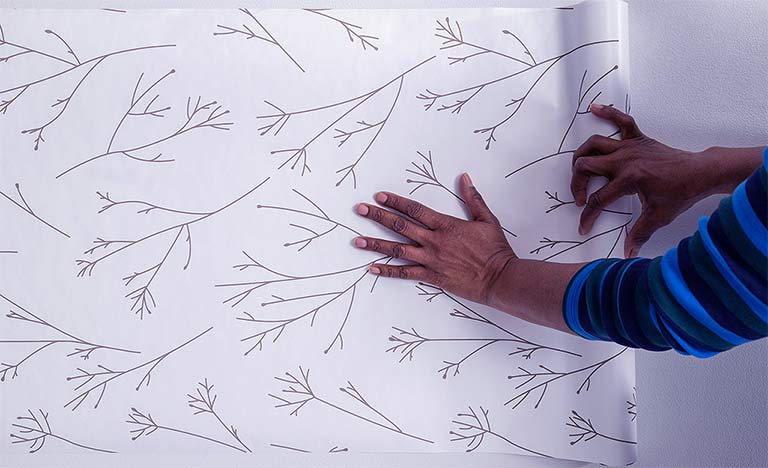What are the necessary tools for peel and stick wallpaper installation? People have different opinions about home improvement, especially when it comes to peel stick wallpaper. Some people feel that any changes made to the house can drastically improve its value, no matter how minor they may be. Others believe it’s best to keep a home as close to original as possible. However, you feel about it is up to you, and no one has a say in your opinion but yourself. I feel you should not wholly ignore peel stick wallpapers, especially if it seems like your only option for decorating.
People who are thinking about doing a home improvement project and want to use peel and stick wallpaper as an alternative to painting should keep in mind that the installation of this kind of wall covering is usually more involved than simply slapping up the paper and smearing on some paste.
Most people who choose to install peel and stick wallpaper are to make it look just like the ordinary kind even though it’s not. It can be done, but at least one person in the house needs to know what they are doing when working with these wallpapers or you’ll be stuck with a really ugly-looking wall. Let’s now get back to the question of the day, what are the necessary tools for peel and stick wallpaper installation?
The best possible answer to this question is not an easy one. There are many things you’ll need to complete the installation of these wallpapers, but I can’t name all of them since it will look like a laundry list for your home improvement project. Only the basic tools necessary for any wallpapering project should be considered mandatory, which means
Tools most people will need for this project include
Measuring Tape
You’ll need a measuring tape to work out the dimensions of your room before you can start putting up papers on your walls. The first thing you do should be marking where you want to put up floral wallpaper peel and stick by using blue chalk or pencil instead of rulers and yardsticks. It’s much easier to measure the distance between two points with a measuring tool than it is to measure out paper with a ruler or yardstick.
Sponge and gentle cleaner
You’ll probably need to clean the walls before you can begin working with peel stick wallpapers or you will end up swirling smears of adhesive everywhere. Sponge on a gentle cleaner, then dry with a soft cloth. This is usually done while shopping for your wallpaper; ask what kind of cleaners are best for the papers you want to use.
Pencil and Plastic Bag
Plastic bags and pencils can be used to cover outlets, switches and furniture you don’t want to get adhesive on. Toss the plastic bag over them then use a pencil to trace their outline before cutting the bag open with scissors. This will leave you with a template for covering these appliances while work is being done around them.
Level
It would help if you used a level when putting up the wallpaper so you can ensure they are all straight and evenly spaced. This will also help you to avoid that unprofessional homemade look that can be achieved when putting up papers wonky and haphazardly.
Wallpaper Adhesive
Peel and stick wallpapers need adhesive to work properly so be sure you have plenty of this stuff. You may want to consider buying a premixed formula instead of mixing your own at home. The store-bought mix is more expensive but it’s one less thing you have to worry about doing right for this project.
Scissors
You need sharp scissors or utility knives to cut wallpaper into strips or pieces that will be used for smaller areas. If you have a bunch of paperwork involved with your project there is a good chance you’ll need a putty knife for spreading adhesive on the wall so it’s best to have one handy too.
Utility Knife
You may need to cut corners in order for your papers to fit properly but it will be impossible to do with the corner applicator. Using a simple utility knife is much more effective in cutting out pieces that won’t fit in the wall. Some people are really good at this stuff but if you are new to it, I suggest using the utility knife instead of your bare hands.
Wallpaper Smoother
While not mandatory for most papers, people who decide to use heavier ones will need a wallpaper smoother in order to get rid of air bubbles and ripples so you don’t have any lines running through your papers.
Corner Applicator
You can get a corner applicator from any wallpaper store or place where they sell supplies for home improvement projects. This tool is designed to help you put the ends of the paper on the wall so it will look like it seamlessly continues. However, if you try to use a normal brush instead of this tool, you run the risk of making a huge mess out of things. You won’t be able to stop at corners and that will probably end up with wallpaper lining your floor as well as your ceiling.
Steel Ruler or Straight Edge
Steel rulers and straight edges will definitely come in handy for this project. You’ll probably need to cut papers into smaller pieces and if you use a steel ruler you won’t have to deal with the mess of cutting on your carpet or floor.
Other necessary tools include blue masking tape, paintbrush, rubber gloves, wallpaper brush (for smoother papers), paint tray, large sponge roller brush, a bucket of water, wallpaper seam roller (if you are working with patterned papers).
Now that you have the list of tools needed for your project you can go about getting them or wait until your supplies arrive. Now would be a good time to turn on some music and dance around like an idiot, while you work up an appetite for your favorite wallpaper installation Video tips.
The list is not yet the complete meaning of necessary tools for peel and stick wallpaper installation that you can find several other tools necessary when you’re applying depending on the type of wallpapers you are using and how the surface looks and feels.

I love all things tech, and I wear many hats – tech lover, business starter, digital marketer, and blogger. I know the ins and outs of Digital Marketing, SEO, SEM, SMM, and how to generate leads. My goal? Making things simple for you with clear guides and reviews. I stumbled upon WordPress while creating my first business site, and I fell in love with it right away. When I’m not building websites, creating content, or boosting clients’ online efforts, I’m focused on staying healthy, hanging out with family, and exploring the world. Connect with me on Facebook, Twitter, Linkedin, or read my complete biography.


